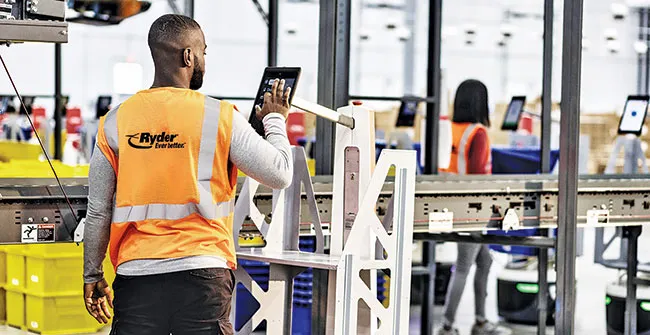Special to Transport Topics
Logistics Supply Chain Shows Steadiness Amid Rough Waters

[Stay on top of transportation news: Get TTNews in your inbox.]
During the past four years, supply chain and logistics companies have ridden the highs and lows of a market that included a pandemic and fractured economy to keep goods moving. Now, the industry is looking to build on lessons learned during the chaotic period while embracing new technologies and business models, in addition to preparing for the next major supply chain disruption.
“In COVID, household goods just took off,” said Ashley Yentz, vice president of supply chain strategy and material flow at smart bed retailer Sleep Number Corp. Yentz was part of a panel session discussing supply chain resiliency and the pandemic during the Manifest conference in Las Vegas on Feb. 10-12. “People had disposable income; we had a large volume shift in our network. We also manufacture a smart bed, which means our bed utilizes chips. And if you recall, we had a large chip shortage in our global supply chain. So very quickly, we found out that we had a large shortage that we had to remedy.”
That shortage wasn’t just felt by manufacturers relying on processors, semiconductors and hard drives. Companies with stable goods that relied on just-in-time inventory management found themselves dealing with enormous spikes in demand, said Tim Judge, president and CEO of Agillitics, a provider of supply chain analytics software and consulting.
Judge was a panelist at Manifest.
“I’m sure you all remember the toilet paper and paper towel type stuff, but really a lot of goods across the board were affected,” he told the conference crowd.
Third-party logistics companies had unique challenges to navigate as well. Gary Allen, vice president of supply chain excellence for Ryder, summed up the position of his company — and other 3PLs — during the uncertain times.
“Never shut down,” he noted. “You have to keep goods moving. People have to eat.”
Allen said some manufacturing segments slowed down, such as automotive and some manufacturing segments. Adding to the challenge were the unique issues regarding just getting goods into the country, he noted.
“It was extremely complicated because not only did everything slow down, but you also had the back up in the ports, and just trying to make sure our employees were safe,” Allen explained. “It was a huge challenge.”

Kruciak
The strains, however, placed a spotlight on the logistics industry, said Nura Kruciak, vice president and vertical lead for client services at Geodis.
Before the pandemic, many people, even in her own family, had a hard time understanding the industry in which she works.
“You all of a sudden saw in mainstream news discussions on port congestion, companies not being able to get their containers out, chassis issues,” Kruciak said. “People really understood what we do and how vital it is.”
Sleep Number Corp.’s Yentz explained that such an environment was an opportunity to discuss solutions in achieving supply chain resiliency: balancing driver availability, chassis and warehouse space; finding alternative routes and points of entry; and looking at speed of transport. The goal is to ensure shortages and unexpected spikes in demand can be managed without experiencing economywide breakdowns in supply chains.
“We are at a point now where we’re looking down the pipe at, ‘How do we use our inventory that we have in a more realistic way?’ ” she said. “How do we connect our sales and marketing channels with our product management and product portfolio to better utilize what we have on hand?”
Overall, 3PLs have to negotiate a balancing act and flexibility comes at a cost, said Bill Mahoney, chief commercial officer and executive vice president for NFI.

Mahoney
Mahoney said he envisions many customers re-evaluating just-in-time inventory management.
“I think that something that’s going to change post pandemic is what is the consumer’s appetite to wait three days, five days instead of necessarily having it tomorrow,” he said. “Maybe not just-in-time, but something in between.”
Ryder’s Allen said companies once envisioned supply chain networks as fixed, unchanging assets that only rarely changed configuration. He said now, companies have shifted from an annual or bi-annual review of networks to reviews monthly or even weekly.
“It may not mean moving buildings, but it’s looking at the velocity of the material, the inventory, the service levels,” he said. “What nodes do you use? Do you really need to get that product next-day? Can we wait one or two days to maybe decrease transportation costs while meeting the service levels as well? It really is a balancing act.”
Allen also noted costs are consistent in that they are only going in one direction. Besides fuel, labor expenses are significantly higher. A warehouse worker, who was at $15 an hour five years ago is now paid $25, he noted.
“Maybe our labor costs are going up, but can we distribute inventory across multiple nodes and maybe shrink the inventory footprint slightly to mitigate some of those cost increases?” he said. “But every time you add a new node in a supply chain, it costs money. And the real estate cost has skyrocketed, too. Lack of warehouse availability has constrained the market. It is a balancing act.”

NFI's Mahoney says 3PLs have to negotiate a balancing act, and flexibility comes at a cost. He predicts that, down the line, many customers will re-evaluate just-in-time inventory management. (NFI)
NFI’s Mahoney said industrial real estate costs are forcing companies to look at how warehouse space is being used.
“We’re having to find a way to use more cube in a building, create greater levels of capacity and squeeze more into the box,” Mahoney said. “That flexibility can come at a cost as well. But the reality of it is, industrial real estate rates have really skyrocketed before and after the pandemic. It’s become a lot more expensive to renew a lease on a building you operate. You have to find a way to fit more into it.”
That need to do more with existing warehouse space has companies leaning into technology and automation, Geodis' Kruciak said.
“Five years ago, the customer base didn’t really understand the ROI because it’s millions of dollars and it’s a lot of investment,” she said, adding that customers are increasingly looking at more advanced technological solutions in warehouses.
Although AI has created interest within the industry, Kruciak noted most leaders are cautiously optimistic.
“It has to be something that is making our service better. It’s making our operations better. It’s making our clients better,” she said.
Kruciak and Allen agree that AI solutions are only as good as the data being put in to the programs — and that data and analytics are integral to modern logistics.
“You need to track everything. It’s inventory, it’s orders, it’s shipments status, it’s people. And the underlying visibility of the cost and transactions is critical,” Allen said.

Although robotic technology is growing in the warehouse space, the people component will remain in the automation equation, said Ryder’s Allen. (Ryder)
While further automation and AI will be a part of future innovation, there is a limit on how far robots can go.
“I don’t think there will ever be a situation in our industry where people will not be vitally necessary, but you could support them and supplement that vitality through technology,” Kruciak said.
Allen said the people component will remain in the automation equation.
“We may not need them to pack a box. We may have a robot to do it, but they may have to monitor and do inspection and auditing on the inbound and outbound side,” he said.
Geopolitical Factors
Mahoney said companies are exploring the options of nearshoring or reshoring some parts of their supply chain.
“Nearshoring is absolutely real,” Mahoney said. “We start looking 20, 30 years down the road, we can tell our cross-border business is up. We can see large companies taking manufacturing out of Southeast Asia, moving it into Mexico.”

Allen
Allen said Ryder is predicting the same trend.
“Automotive, industrial, high tech, some level of consumer products — there’s been a shift,” he said.
Geodis’ Kruciak added high-tech industries are leading the way for nearshoring and reshoring manufacturing.
“The U.S. has made substantial investments to onshore certain manufacturing for our high-tech customers, subsidizing these big manufacturing plants for semiconductors,” she said. “The pandemic was a catalyst for that.”
Looking ahead, Kruciak expects the election will have an impact on the business climate.
“We are still the strongest GDP in the world. And as our economy goes, the world follows. My hope is that we should see an improvement in spending,” she noted. “We should see an improvement in volumes. I think maybe as quickly as Q3 and Q4 of this year.”
Allen sees companies doing more to lessen the impact of future disruptions, relying on data and analytics to predict problems.

Fleets are doing more to lessen the impact of future disruptions, using data and analytics to predict supply chain problems. (Ryder)
“Analytics is the key to success, because if you can’t measure how well you’re doing something, I don’t see how you can optimize and react quickly,” he said. “I see continued advancements in analytics, including progressions toward more advanced AI models, getting into predictive capabilities.”
Mahoney said he thinks the industry has hit bottom in terms of rates and volume.
“I think companies understand what they want to store. I think they understand what they need from a capacity standpoint in their supply chain,” he said. “I think we’re going to see rates finally start to come up a little bit in the transportation market.”
One thing being prepared against, however, is the next disruption.
“The only certainty in forecasting demand is that it’ll be uncertain,” Agillitics’ Judge said. “And I think obviously the last four years showed that.”
Want more news? Listen to today's daily briefing below or go here for more info:




